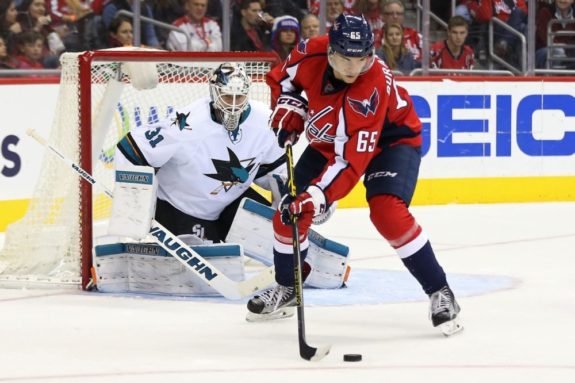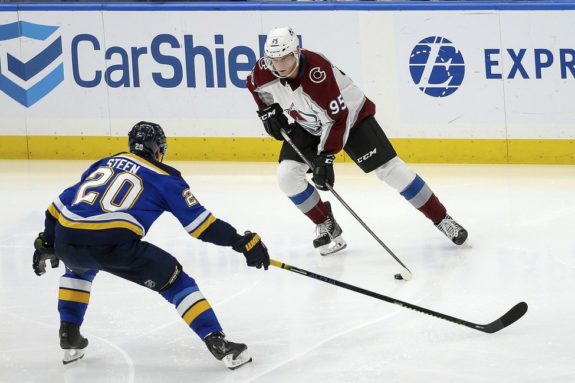
 Shane Andrews
The Hockey Writers
Shane Andrews
The Hockey Writers
21
Reads
0
Comments
Avalanche: Predicting André Burakovsky’s Next Contract
Drafted 23rd overall by the Washington Capitals in 2013, and acquired by the Colorado Avalanche in June 2019 for a 2020 second-round pick, 2020 third-round pick, and the signing rights to Scott Kosmachuk, André Burakovsky has now settled into a role in the Avalanche’s top six.
At the time of writing, Burakovsky is 24 years old and is on an expiring contract. He is on pace to set career highs in both goals and assists (and hence points), and is therefore likely due for a raise in his next deal.
I want to try to estimate what his next contract will look like.
In order to do this, I’m going to look at his career and contract comparables. By comparables, I mean the contracts of players who had similar production to Burakovsky at their time of signing. All of the contract and player production information is taken from Capfriendly.
Burakovsky’s Career
During his time with the Capitals, Burakovsky struggled to find a role for himself. In the five seasons, he appeared in 328 of 410 regular season games, missing an average of 16 games per season (either due to injury, being benched, or being sent down to the American Hockey League earlier in his career).
His highest scoring season with the Capitals was in 2015-16, when he put up 17 goals and 21 assists in 79 games (0.48 points per game). However, he beat out those numbers on a per game basis in in 2016-17, when he put up 12 goals and 23 assists in 64 games (0.55 points per game).

After the 2016-17 season, when his entry-level contract expired, the Capitals re-signed him to a two-year, $6 million contract as follows:
- 2017-18: $500,000 signing bonuses, $2.25 million salary
- 2018-19: $0 signing bonuses, $3.25 million salary
When this contract expires, Burakovsky will still be a restricted free agent (RFA), with a qualifying offer of $3.25 million (meaning the team has to either offer him a one year, $3.25 million extension or he will become an unrestricted free agent).
In each of the next two seasons, he put up 12 goals and 13 assists, playing 56 games in 2017-18 and 76 games in 2018-19.
Then, on June 29, 2019, he was traded to the Avalanche and on July 15, signed a one-year, $3.25 million contract with the club. When this contract expires in 2020, he will still be an RFA.
Since the start of the season, Burakovsky has fit comfortably in the Avalanche’s top six, with the occasional stint on the top line because of injuries. He has produced at at a career-best rate, with 15 goals and 18 assists in 46 games. At his current pace, over 82 games he would notch 27 goals and 32 assists.

Being given an opportunity to succeed with the Avalanche has allowed Burakovsky to reach new heights with his game. One would expect that at the end of his current contract he is set up to get a bump in pay. But, how much of a raise should one expect exactly?
Of course, RFA contracts and holdouts have been pretty crazy over the last year or two, but it’s hard to view Burakovsky in the same light as many of the forwards who held out over this past summer, given that many of them were producing at a pace close to a point per game or higher (players like Mitch Marner, Brayden Point, Matthew Tkachuk, etc.).
Using Contract Comparables to Predict Burakovsky’s Next Deal
One thing we know is that if Burakovsky stays with the Avalanche next season, he will make at least $3.25 million on a one-year contract. Given his production, though, $3.25 million is a little bit low. What can he realistically be expected to sign for?
Here are some players who had similar production to Burakovsky in their RFA years, who then signed a contract extension. I’m going to list the players production rates, as well as their contract’s salary cap percent and average annual value (AAV). The players are:
- Jonathan Huberdeau: 20 goals, 39 assists in 76 games played. Signed for six years, $35.4 million (8.08% of salary cap — $5.9 million AAV)
- Nino Neiderreiter: 25 goals, 32 assists in 82 games played. Signed for five years, $26.25 million (7% of salary cap — $5.25 million AAV)
- Ondrej Palat: 17 goals, 35 assists in 75 games played. Signed for five years, $26.5 million (7.07% of salary cap — $5.3 million AAV)
- Alex Galchenyuk: 17 goals, 27 assists in 61 games played. Signed for three years, $14.7 million (6.53% of salary cap — $4.9 million AAV)
All of these comparables are based solely on production (I didn’t look at advanced statistics for this article). Of course, some of these contracts are turning out to be quite good in value, Huberdeau in particular.

From the above, we can estimate that if Burakovsky is signed to a decent extension (say, five or six years), we can expect the cap hit to be somewhere in the neighbourhood of 7%-8% of the salary cap.
Given that the salary cap increases every year by a couple of million, we can project that in 2020-2021 the cap could be as high as $84 million. In such a scenario, a six-year, 7.5% of the salary cap contract would work out to have an AAV of $6.3 million. That’s not bad for Burakovsky, who can (hopefully) put up 25 goals and 60 points consistently every season.
No doubt the Avalanche can afford it with their current cap situation, but they should still be careful with who they target at the trade deadline.
Acquiring players who have an extra year or more left on their contract could impact their ability to sign their expiring RFAs, as Burakovsky is not their only one due for a raise next season.
It is entirely possible that the team moves some of their expiring RFAs in a trade that nets them a player that has more than one year remaining in their current contract with a higher cap hit.
With this in mind, it will be interesting to see who the team pursues at the deadline, and how Burakovsky (and others) fit into their plan for next season.
The post Avalanche: Predicting André Burakovsky’s Next Contract appeared first on The Hockey Writers.
Popular Articles

















































 Blackhawks Chicago
Blackhawks Chicago Panthers Florida
Panthers Florida Penguins Pittsburgh
Penguins Pittsburgh Rangers New York
Rangers New York Avalanche Colorado
Avalanche Colorado Kings Los Angeles
Kings Los Angeles Maple Leafs Toronto
Maple Leafs Toronto Bruins Boston
Bruins Boston Capitals Washington
Capitals Washington Flames Calgary
Flames Calgary Oilers Edmonton
Oilers Edmonton Golden Knights Vegas
Golden Knights Vegas Senators Ottawa
Senators Ottawa Lightning Tampa Bay
Lightning Tampa Bay Flyers Philadelphia
Flyers Philadelphia Islanders New York
Islanders New York Sabres Buffalo
Sabres Buffalo Red Wings Detroit
Red Wings Detroit Devils New Jersey
Devils New Jersey Hurricanes Carolina
Hurricanes Carolina Blue Jackets Columbus
Blue Jackets Columbus Predators Nashville
Predators Nashville Wild Minnesota
Wild Minnesota Blues St. Louis
Blues St. Louis Stars Dallas
Stars Dallas Jets Winnipeg
Jets Winnipeg Mammoth Utah
Mammoth Utah Sharks San Jose
Sharks San Jose Canucks Vancouver
Canucks Vancouver Ducks Anaheim
Ducks Anaheim






